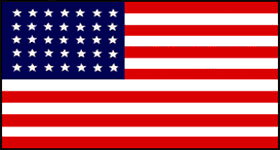 |
Civil War Battles |
|
State War Records |
| AL - AK - AZ - AR - CA - CO - CT - DE - FL - GA - HI - ID - IL - IN - IA - KS - KY - LA - MA - MD - ME - MI - MN - MS - MO - MT - NE - NV - NH - NJ - NM - NY - NC - ND - OH - OK - OR - PA - RI - SC - SD - TN - TX - UT - VT - VA - WA - WV - WI - WY |
The Battle of Piedmont
June 5-6, 1864 in Piedmont, Augusta County, Virginia
 |
|||||||||||||||||||||
|
After replacing Maj. Gen. Franz Sigel in command of Union forces in the Shenandoah Valley, Maj. Gen. David "Black Dave" Hunter renewed the Union offensive. Shortly after dawn, 5 June, Union cavalry advanced on the Staunton Road and met Confederate cavalry under Brig. Gen. John D. Imboden at Mt. Meridian. The Union troopers were driven back until reinforced and again advanced to Mt. Meridian, supporting their attack with 10 field pieces. The Confederates responded with 2 guns. Imboden continued to delay the Union advance, while gradually retiring. Union cavalry incurred about 100 casualties in the morning's action. Fighting occurred around Bonny Doon. In the wake of the cavalry, Union infantry marched south from Port Republic.
Gen. William Jones deployed his army in an ``L'' anchored on a bend of Middle River facing north and bending south along the ridge line. He placed his 2 veteran brigades (under Col. Beuhring Jones and Col. William H. Browne) on the left and center behind barricades of fence rails. His reserves, which consisted of home guards, were drawn up in the woods just south and west of Piedmont. Vaughn's cavalry brigade was in position along the Cross Road east of Piedmont. His line was supported by artillery. Jones made his headquarters in a tent in the yard of the modern McDonald House. (Imboden's cavalry brigade after the morning's delaying action withdrew behind Polecat Draft near Round Hill.)
About 10:00 A.M., Union cavalry drove the Confederate troopers back to the main infantry line at Piedmont and then withdrew out of cannon range to await the arrival of their infantry and artillery. Moor's brigade arrived first and deployed to the right of the road into the river bend. They were fired on by Confederate skirmishers. Thoburn's brigade deployed to the left of the road in the vicinity of the Shaver House. DuPont arrayed his artillery battalion on the heights confronting the Confederate position. Hunter made his headquarters in the Shaver House. One brigade of Union cavalry was held in reserve.
DuPont massed 22 guns against the angle in the Confederate line, eventually forcing two batteries to retire and take up a position closer to Piedmont village. Shortly after noon, elements of Moor's brigade assaulted the hill to their right front, driving out the Confederate skirmishers. Supported by a regiment of Thoburn's brigade, Moor's entire line advanced, driving back the advanced Confederate line on the northern brow of the ridge. Jones withdrew his infantry to barricades along Walker's Lane, reinforced his left to meet the Union charges, and launched a counterattack. Fighting swayed back and forth across the fields. Hunter now reinforced Moor with Wynkoop's cavalry brigade, fighting dismounted, and renewed his attack.
While fighting raged on the right, Col. Thoburn led 3 regiments through a ravine and woods on the left and attacked across the Givens Run Valley. Mid-afternoon, he charged directly into a gap in the Confederate line that was opened when Jones reinforced his left flank. Confederate reserves were advancing to fill the gap but Thoburn's regiment reached the crest first, and a savage, hand-to-hand mel‚e erupted. About this time, Jones was killed, and the Confederate defense came unraveled. Inexplicably, the Confederate cavalry (Vaughn) witnessed Thoburn's attack but did not advance.
Pressed on the front and rear, Confederate soldiers went streaming over the steep bluffs behind to wade and swim the river. All order was lost. A nasty skirmish was fought over possession of the ford to the rear of the Col. Crawford House. Stahel's Union cavalry division advanced on the far left to close in on the village by the Cross Road. They were met by Vaughn's and Imboden's cavalry who at last came into play to act as rear guard. Some Confederate units attempted to stand near the Middle River Church and at New Hope, and Union pursuit gradually slackened.
Hunter occupied Staunton on June 6 and, after a pause to await the arrival of Brig. Gen. George Crook's column, began to advance on Lynchburg, destroying military stores and public property in his wake.
